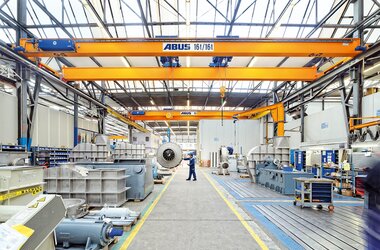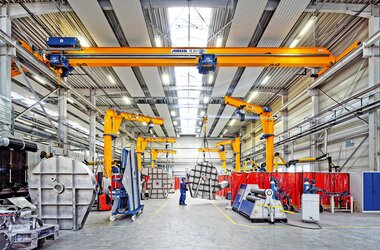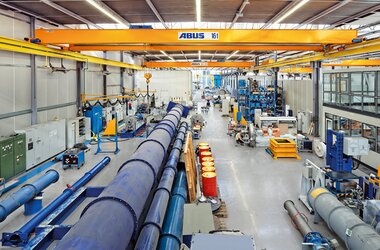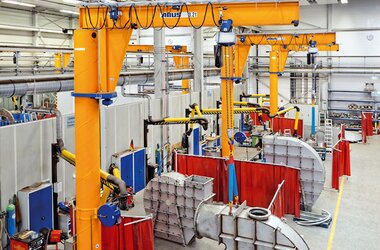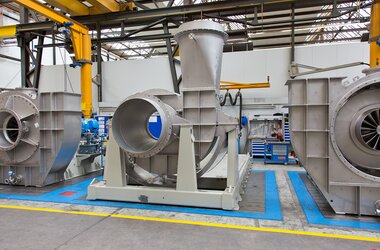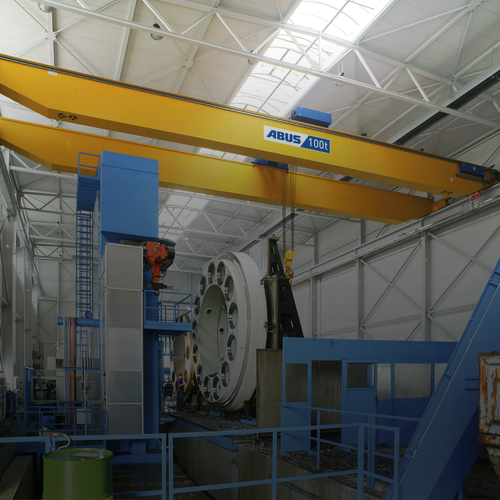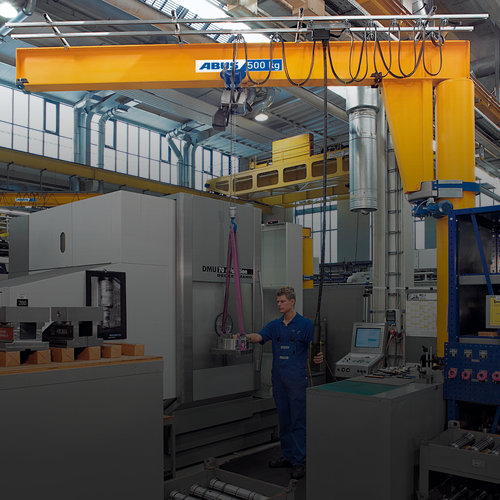ABUS EOT cranes and jib cranes working for industrial fans
The Piller Blowers & Compressors GmbH (www.piller.com) emerged from the Anton Piller machine works founded in Hamburg, Germany, in 1909 which used to make organ and forge bellows in the beginning. Today headquarters are located in Moringen, a town in the German state of Lower Saxony, and the company is ranked among the leading producers of high performance blowers and compressors.
About 300 staff are employed at Moringen and in 2013 a total of 859 industrial fans were produced. PILLER, a medium-sized global player, exports about 85 % of its products. PILLER has branches in the US, in Singapore, and in China, a joint venture in Korea, and an international network of sales and service partners. The products produced are made to customer specific requirements and are key components in processing plants (industrial installations) such as refineries, chemical plants, waste water treatment plants, industrial furnaces, and power stations to name but a few. The high-tech blowers serve to convey and to compress gases, to dry moist materials, to supply industrial furnaces with combustion air, to extract flammable gases and much, much more. The comprehensive customer service provided by PILLER offers an all-round package including development, project planning, construction, and production. Extensive customer services such as installation and commissioning, inspections, maintenance and repairs as well as economical and technical system optimisation are also on offer on top of the spare parts service provided for blowers and compressors.
The company continually strives to optimise their production processes and their services provided. Recently a new production plant with a surface of 1.750 m² was completed at headquarters. The production layout was optimised by moving machinery to different locations and by new investments. Several types of EOT cranes and of jib cranes were installed in the new production building. Once this construction work was completed the upgrading of the existing production plants was tackled in the summer of 2013. The aim was to bring the existing plant with its cranes dating from the 1970s up to modern requirements and transport tasks. The local ABUS agency was challenged to install new cranes with higher lifting capacities that would not require any reinforcement of the existing building structure or of the crane tracks. The cranes, of course, should be up to the current requirements of material flow and transport. This ambitious goal was achieved by installing several ABUS double girder cranes of the ZLK type with lifting capacities between 8 and 30 tonnes and spans of 19.2 metres. All cranes are radio remote controlled and come with large load displays so that the crane user can easily read the load on the hook even from a considerable distance. As requested, the new EOT cranes boast substantially higher load capacities that were made possible by using cranes with 8 wheels and taking into account the wheel loads and wheel bases specified by the structural engineer. At the same time higher lifting heights and increased operating clearance below the crane bridge could be achieved by the new cranes. The EOT cranes are predominantly used for transport in the individual bays but also to load the finished products in the shipping hall. The different workstations in the production where the main components of the fans are treated and individual components are turned and positioned have been equipped with ABUS jib cranes. These jib cranes are specific to the respective workplaces and have lifting capacities between 1 and 2 tonnes, jib arm lengths of 5.5 metres and are 6.6 metres high. The jib cranes proved to be very flexible when the production layout was optimised as the existing cranes could be dismounted and reinstalled in a different place with the help of dowel plates. Some jib cranes were also upgraded with electric trolley travelling and electric slewing motors. Radio remote controls make it easier to operate the jib cranes the same as they did make it easier to control the EOT cranes.
The newly installed EOT cranes and the upgraded jib cranes now work in perfect harmony on two different material flow levels and are the optimal transport solution for the company PILLER. The following comment made by the head of maintenance sums up the satisfaction of the customer: “Now when I glance into the hall from my office I always have the new cranes right in front of my eyes, even at eye level; it is as if the sun was rising!”



